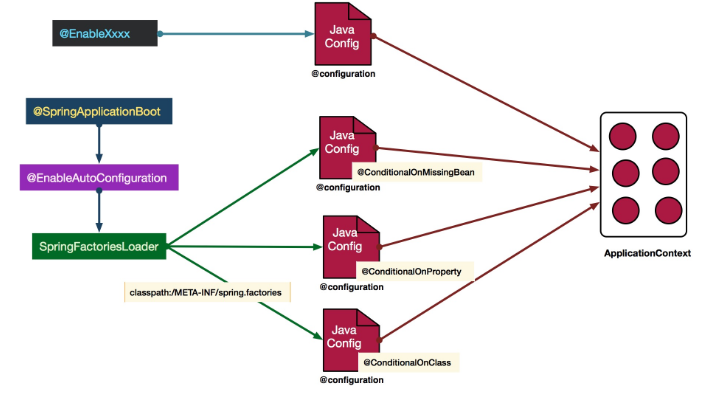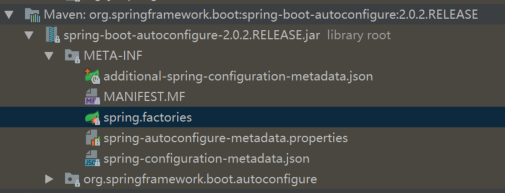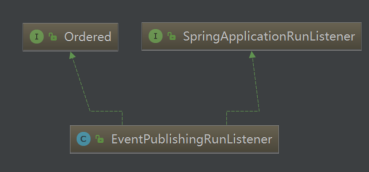一、前言
上一篇介绍了注解,也是为这一篇做铺垫,传统的都是通过配置文件来启动spring,那spring boot到底是做了什么能让我们快速开发昵?
二、启动原理
看下程序启动的入口,主要两处地方一是SpringBootApplication注解,另外就是run方法,首先我们看注解部分,上一篇我们也说过注解应该不难看懂,我们看下这个注解里面有什么神奇的东西;

@SpringBootApplication public class DemoApplication { public static void main(String[] args) { SpringApplication.run(DemoApplication.class, args); } } @Target(ElementType.TYPE) @Retention(RetentionPolicy.RUNTIME) @Documented @Inherited @SpringBootConfiguration @EnableAutoConfiguration @ComponentScan(excludeFilters = { @Filter(type = FilterType.CUSTOM, classes = TypeExcludeFilter.class), @Filter(type = FilterType.CUSTOM, classes = AutoConfigurationExcludeFilter.class) }) public @interface SpringBootApplication { /** * Exclude specific auto-configuration classes such that they will never be applied. * @return the classes to exclude */ @AliasFor(annotation = EnableAutoConfiguration.class) Class<?>[] exclude() default {}; /** * Exclude specific auto-configuration class names such that they will never be * applied. * @return the class names to exclude * @since 1.3.0 */ @AliasFor(annotation = EnableAutoConfiguration.class) String[] excludeName() default {}; /** * Base packages to scan for annotated components. Use {@link #scanBasePackageClasses} * for a type-safe alternative to String-based package names. * @return base packages to scan * @since 1.3.0 */ @AliasFor(annotation = ComponentScan.class, attribute = "basePackages") String[] scanBasePackages() default {}; /** * Type-safe alternative to {@link #scanBasePackages} for specifying the packages to * scan for annotated components. The package of each class specified will be scanned. * <p> * Consider creating a special no-op marker class or interface in each package that * serves no purpose other than being referenced by this attribute. * @return base packages to scan * @since 1.3.0 */ @AliasFor(annotation = ComponentScan.class, attribute = "basePackageClasses") Class<?>[] scanBasePackageClasses() default {}; }
看上面代码,除去元注解,主要有3个注解,
@ComponentScan
这个不需要我们多说太多,这个主要有2个作用,组件扫描和自动装配;
@SpringBootConfiguration
这个我们也不需要说太多,这个注解主要是继承@Configuration注解,这个我们就是为了加载配置文件用的;
@EnableAutoConfiguration
这个是我们的重点:

看图我们来走一下代码,这里有一个重点就是@Import注解,这个里面引入了AutoConfigurationImportSelector.class这个文件,所以我们就需要看下这里面有那些玩意,值得我们注意的,这个类里面代码有点多我将重点放到下一个代码片段中,让大家结构清晰一些;

@Target(ElementType.TYPE) @Retention(RetentionPolicy.RUNTIME) @Documented @Inherited @AutoConfigurationPackage @Import(AutoConfigurationImportSelector.class) public @interface EnableAutoConfiguration { String ENABLED_OVERRIDE_PROPERTY = "spring.boot.enableautoconfiguration"; /** * Exclude specific auto-configuration classes such that they will never be applied. * @return the classes to exclude */ Class<?>[] exclude() default {}; /** * Exclude specific auto-configuration class names such that they will never be * applied. * @return the class names to exclude * @since 1.3.0 */ String[] excludeName() default {}; }
这是中间比较关键的代码,我们主要看下loadFactories方法,这个里面有个常量的配置,位置如下图所示,整段代码实现了把配置文件中的信息通过反射实例化成为@Configuration的配置文件,然后通过@Configuration最后汇总到容器当中;

protected List<AutoConfigurationImportFilter> getAutoConfigurationImportFilters() { return SpringFactoriesLoader.loadFactories(AutoConfigurationImportFilter.class, this.beanClassLoader); } public abstract class SpringFactoriesLoader { /** * The location to look for factories. * <p>Can be present in multiple JAR files. */ public static final String FACTORIES_RESOURCE_LOCATION = "META-INF/spring.factories"; private static final Log logger = LogFactory.getLog(SpringFactoriesLoader.class); private static final Map<ClassLoader, MultiValueMap<String, String>> cache = new ConcurrentReferenceHashMap<>(); /** * Load and instantiate the factory implementations of the given type from * {@value #FACTORIES_RESOURCE_LOCATION}, using the given class loader. * <p>The returned factories are sorted through {@link AnnotationAwareOrderComparator}. * <p>If a custom instantiation strategy is required, use {@link #loadFactoryNames} * to obtain all registered factory names. * @param factoryClass the interface or abstract class representing the factory * @param classLoader the ClassLoader to use for loading (can be {@code null} to use the default) * @see #loadFactoryNames * @throws IllegalArgumentException if any factory implementation class cannot * be loaded or if an error occurs while instantiating any factory */ public static <T> List<T> loadFactories(Class<T> factoryClass, @Nullable ClassLoader classLoader) { Assert.notNull(factoryClass, "'factoryClass' must not be null"); ClassLoader classLoaderToUse = classLoader; if (classLoaderToUse == null) { classLoaderToUse = SpringFactoriesLoader.class.getClassLoader(); } List<String> factoryNames = loadFactoryNames(factoryClass, classLoaderToUse); if (logger.isTraceEnabled()) { logger.trace("Loaded [" + factoryClass.getName() + "] names: " + factoryNames); } List<T> result = new ArrayList<>(factoryNames.size()); for (String factoryName : factoryNames) { result.add(instantiateFactory(factoryName, factoryClass, classLoaderToUse)); } AnnotationAwareOrderComparator.sort(result); return result; } /** * Load the fully qualified class names of factory implementations of the * given type from {@value #FACTORIES_RESOURCE_LOCATION}, using the given * class loader. * @param factoryClass the interface or abstract class representing the factory * @param classLoader the ClassLoader to use for loading resources; can be * {@code null} to use the default * @see #loadFactories * @throws IllegalArgumentException if an error occurs while loading factory names */ public static List<String> loadFactoryNames(Class<?> factoryClass, @Nullable ClassLoader classLoader) { String factoryClassName = factoryClass.getName(); return loadSpringFactories(classLoader).getOrDefault(factoryClassName, Collections.emptyList()); } private static Map<String, List<String>> loadSpringFactories(@Nullable ClassLoader classLoader) { MultiValueMap<String, String> result = cache.get(classLoader); if (result != null) { return result; } try { Enumeration<URL> urls = (classLoader != null ? classLoader.getResources(FACTORIES_RESOURCE_LOCATION) : ClassLoader.getSystemResources(FACTORIES_RESOURCE_LOCATION)); result = new LinkedMultiValueMap<>(); while (urls.hasMoreElements()) { URL url = urls.nextElement(); UrlResource resource = new UrlResource(url); Properties properties = PropertiesLoaderUtils.loadProperties(resource); for (Map.Entry<?, ?> entry : properties.entrySet()) { List<String> factoryClassNames = Arrays.asList( StringUtils.commaDelimitedListToStringArray((String) entry.getValue())); result.addAll((String) entry.getKey(), factoryClassNames); } } cache.put(classLoader, result); return result; } catch (IOException ex) { throw new IllegalArgumentException("Unable to load factories from location [" + FACTORIES_RESOURCE_LOCATION + "]", ex); } } @SuppressWarnings("unchecked") private static <T> T instantiateFactory(String instanceClassName, Class<T> factoryClass, ClassLoader classLoader) { try { Class<?> instanceClass = ClassUtils.forName(instanceClassName, classLoader); if (!factoryClass.isAssignableFrom(instanceClass)) { throw new IllegalArgumentException( "Class [" + instanceClassName + "] is not assignable to [" + factoryClass.getName() + "]"); } return (T) ReflectionUtils.accessibleConstructor(instanceClass).newInstance(); } catch (Throwable ex) { throw new IllegalArgumentException("Unable to instantiate factory class: " + factoryClass.getName(), ex); } } }

基本上注解这块就是说完了,但是中间少说了几个比较重要的东西,这里要说下需要注意的2个问题,
1.exclude和excludeName这个两个主要时排除你不想加载的配置,用法很简答,不需要说他太多;
2.scanBasePackages和scanBasePackageClasses这个是为了指定运行目录,好多小伙伴做了项目分离以后,会读取不到Mappr等,可以考虑下是不是这个错误;
重点来了,上面说了加载什么东西,那这些东西啥时候被调用被触发,那我们看下我们重点run方法:
1.调用run方法之前,首先初始化SpringApplication对象实例,这个对象初始化的过程中也做了不少事情让我们来慢慢看起来,接上上面思路,继续完成我们的取经;

//初始化SpringApplication对象 public SpringApplication(ResourceLoader resourceLoader, Class<?>... primarySources) { //加载classpatch文件下面的配置文件 this.resourceLoader = resourceLoader; Assert.notNull(primarySources, "PrimarySources must not be null"); this.primarySources = new LinkedHashSet<>(Arrays.asList(primarySources)); //判断是否是web运行环境 this.webApplicationType = deduceWebApplicationType(); //使用SpringFactoriesLoader在应用的classpath中查找并加载所有可用的ApplicationContextInitializer。 setInitializers((Collection) getSpringFactoriesInstances( ApplicationContextInitializer.class)); //使用SpringFactoriesLoader在应用的classpath中查找并加载所有可用的ApplicationListener。 setListeners((Collection) getSpringFactoriesInstances(ApplicationListener.class)); //获得当前执行main方法的类对象 this.mainApplicationClass = deduceMainApplicationClass(); }
ApplicationContextInitializer 接口是在spring容器刷新之前执行的一个回调函数,主要有2点作用:1.在上下文(ConfigurableApplicationContext)刷新(refresh)之前调用,2.通常被用作web应用,在一些程序设计在spring容器初始化使用。比如说注册一些配置或者激活一些配置文件针对(ConfigurableApplicationContext的getEnvironment()方法)。另外这个函数支持支持Order注解。并且代表着执行顺序。我在下面也写了一个简单的例子,同时这个也是支持在配置文件中配置的context.initializer.classes=后面加上回调函数的全限定名称;另外假设我们在当前项目中要引入别的jar,这个jar要在加载前做一些配置,这个时候我们项目下的resources下新建META-INF文件夹,文件夹下新建spring.factories文件,然后写上org.springframework.context.ApplicationContextInitializer=后面加上需要回调函数的全限定名称,这个是在主项目启动的时候就会优先加载了;
ApplicationListener接口是spring boot的监听器,有7种类型,我准备好了demo大家执行一下,我相信对下面run方法的运行就不是很迷惑了;

@Order(3) public class TestApplicationContextInitializer implements ApplicationContextInitializer { @Override public void initialize(ConfigurableApplicationContext applicationContext) { System.out.println(applicationContext.getBeanDefinitionCount()+applicationContext.getBeanDefinitionNames().toString()); } } @Order(1) public class TestApplicationContextInitializer2 implements ApplicationContextInitializer { @Override public void initialize(ConfigurableApplicationContext applicationContext) { System.out.println(applicationContext.getDisplayName()); } } @SpringBootApplication public class DemoApplication { public static void main(String[] args) { // SpringApplication.run(DemoApplication.class, args); SpringApplication springApplication=new SpringApplication(DemoApplication.class); springApplication.addListeners((ApplicationListener<ApplicationStartingEvent>) event->{ System.out.println("Starting"); }); springApplication.addListeners((ApplicationListener<ApplicationStartedEvent>) event->{ System.out.println("Started"); }); springApplication.addListeners((ApplicationListener<ApplicationFailedEvent>) event->{ System.out.println("Failed"); }); springApplication.addListeners((ApplicationListener<ApplicationPreparedEvent>) event->{ System.out.println("Prepared"); }); springApplication.addListeners((ApplicationListener<SpringApplicationEvent>) event->{ System.out.println("SpringApplication"); }); springApplication.addListeners((ApplicationListener<ApplicationEnvironmentPreparedEvent>) event->{ System.out.println("EnvironmentPrepare"); }); springApplication.addListeners((ApplicationListener<ApplicationReadyEvent>) event->{ System.out.println("Ready"); }); springApplication.addInitializers(new TestApplicationContextInitializer()); springApplication.addInitializers(new TestApplicationContextInitializer2()); springApplication.run(args); } }
2.实例化完成开始执行run方法,这个里面流程比较多,我们先来看一个继承关系,然后结合上面ApplicationListener的demo我相信大家已经对其广播实现已经有了一个了解,这里我还是提一下通过SpringApplicationRunListener在ApplicationContext初始化过程中各个时点发布各种广播事件,并由ApplicationListener负责接收广播事件。接下来我们看下启动流程:


public ConfigurableApplicationContext run(String... args) { StopWatch stopWatch = new StopWatch(); stopWatch.start(); ConfigurableApplicationContext context = null; //收集异常 Collection<SpringBootExceptionReporter> exceptionReporters = new ArrayList<>(); //设置Headless模式为全局 configureHeadlessProperty(); //加载所有classpath下面的META-INF/spring.factories SpringApplicationRunListener(不同的时间点发送事件通知) SpringApplicationRunListeners listeners = getRunListeners(args); //spring boot启动初始化开始 listeners.starting(); try { //装配参数和环境 ApplicationArguments applicationArguments = new DefaultApplicationArguments( args); ConfigurableEnvironment environment = prepareEnvironment(listeners, applicationArguments); configureIgnoreBeanInfo(environment); //打印Banner Banner printedBanner = printBanner(environment); //创建ApplicationContext() context = createApplicationContext(); //返回异常 exceptionReporters = getSpringFactoriesInstances( SpringBootExceptionReporter.class, new Class[] { ConfigurableApplicationContext.class }, context); //装配Context prepareContext(context, environment, listeners, applicationArguments, printedBanner); //执行context的refresh方法,并且调用context的registerShutdownHook方法(这一步执行完成之后,spring容器加载完成) refreshContext(context); //回调,获取容器中所有的ApplicationRunner、CommandLineRunner接口 afterRefresh(context, applicationArguments); stopWatch.stop(); if (this.logStartupInfo) { new StartupInfoLogger(this.mainApplicationClass) .logStarted(getApplicationLog(), stopWatch); } //容器初始化完成 listeners.started(context); //遍历所有注册的ApplicationRunner和CommandLineRunner,并执行其run()方法。 //该过程可以理解为是SpringBoot完成ApplicationContext初始化前的最后一步工作, callRunners(context, applicationArguments); } catch (Throwable ex) { handleRunFailure(context, ex, exceptionReporters, listeners); throw new IllegalStateException(ex); } try { //容器开始被调用 listeners.running(context); } catch (Throwable ex) { handleRunFailure(context, ex, exceptionReporters, null); throw new IllegalStateException(ex); } return context; }
写了这么多我忘记放入执行结果了这里补进去:

三、总结
要是想在spring boot初始化的时候搞点事情的化,那么有3种方法:
1.创建ApplicationContextInitializer的实现类
2.创建ApplicationListener的实现类
3.创建ApplicationRunner和CommandLineRunner的实现类
上面2种已经有了demo,我再来写一个第3种的demo;

@Order(2) @Component public class CommandLineRunnerDemo implements CommandLineRunner { @Override public void run(String... args) throws Exception { System.out.println("CommandLineRunnerDemo"); } } @Order(1) @Component public class ApplicationRunnerDemo implements ApplicationRunner { @Override public void run(ApplicationArguments args) throws Exception { System.out.println("ApplicationRunner"); } }
知道启动的流程又懂了扩展,我们接下来开始spring cloud吧。
上面有什么的不懂的可以加群:438836709
也可以关注我公众号

